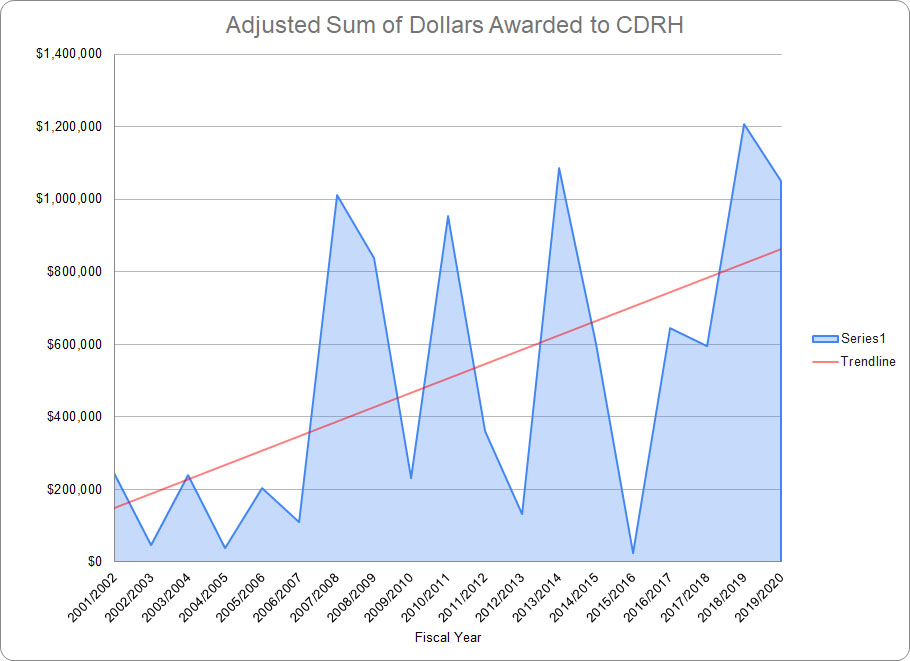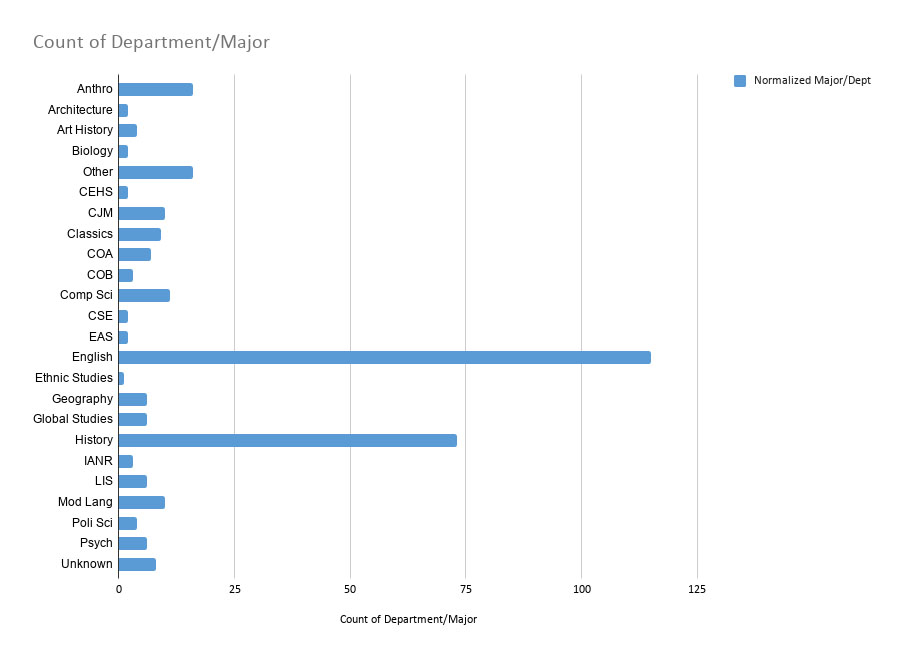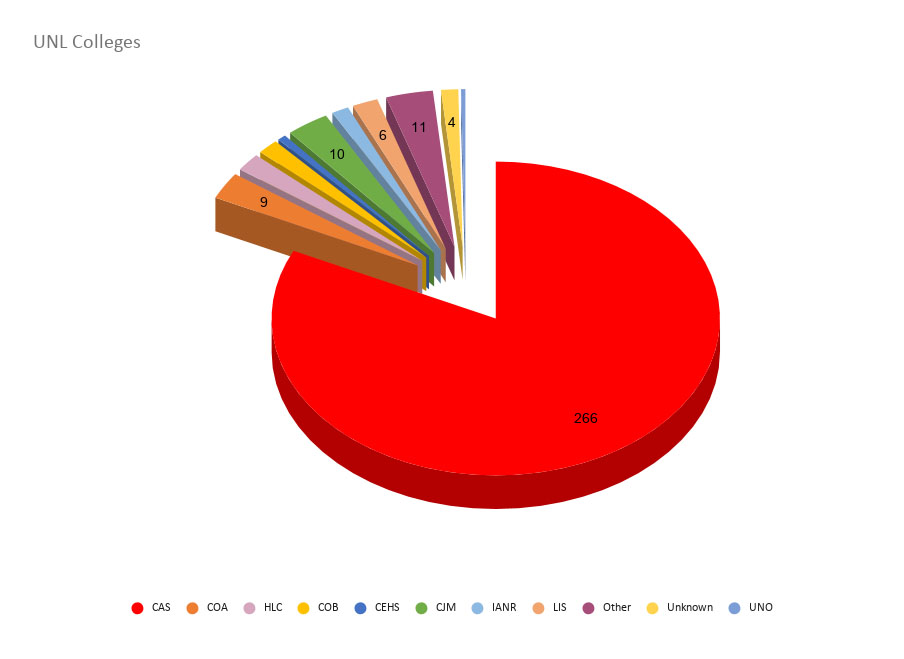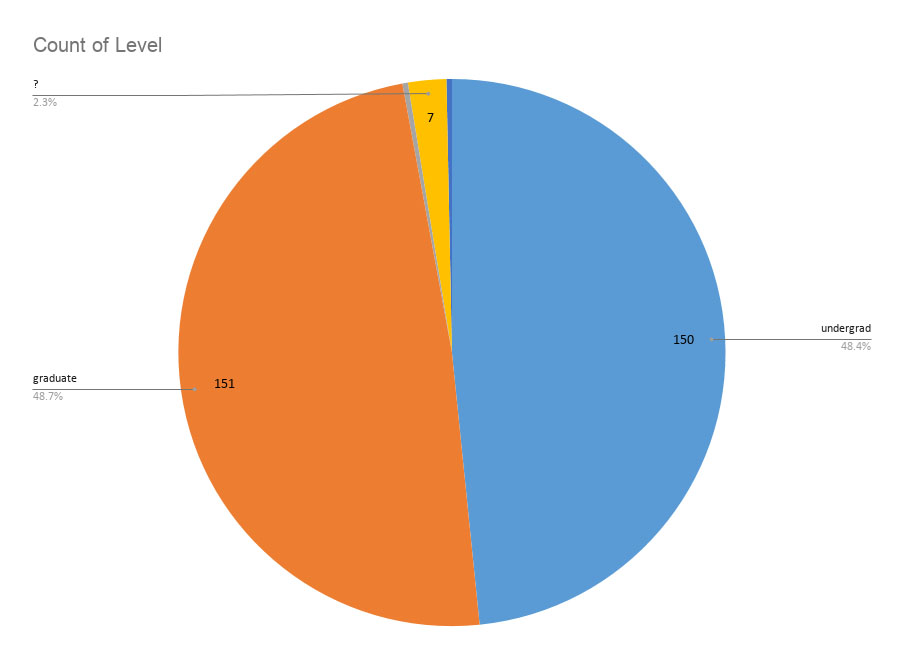CDRH Strategic Objectives 2020
Assembled by the Strategic Planning Task Force: Matt Cohen, Karin Dalziel, Carrie Heitman (Chair) and Isabel Velázquez
- Draft version circulated to CDRH community on September 10, 2020
- Public discussion thereof occurred during CDRH Retreat on September 18, 2020
- Aggregated edits/comments compiled October 1, 2020
- Committee discussed strategies for revision on October 7, 2020
- Committee revisions completed October 22, 2020
- Revised version circulated to CDRH community on October 28, 2020
- Committee revisions completed November 13, 2020
This ad hoc committee was tasked with drafting strategic objectives for the Center for Digital Research in the Humanities. Our process was retrospective (what are our accomplishment metrics for the past 15+ years) as well as prospective (as a community, where do we want to go). We gathered historic data (Appendix A) which helped inform our ideas and metrics for future success.
The following strategic objectives embody a guiding commitment by the CDRH to identify, challenge and change existing structures of systemic racism. This commitment is central to the CDRH’s vision, mission and values and pertains to the ways in which we support students, conduct research and interact with each other and the communities we serve. The fundamental questions guiding these objectives: How do they support anti-racism? How do they help dismantle structural racism? And how will we measure success?
Objective: To redress historical silences
Already a field-leading center of digital humanities scholarship, the CDRH seeks to redress historical silencing of the marginalized and oppressed through increased engagement in critical research, cultural preservation and recovery. The CDRH aims to intensify its work in this space to bring silenced archives to the public; to nurture the next generation of digital humanists ; expand historical research; conduct critical work around “big data” classifications and machine learning, and grow collaborations with underrepresented communities.
Example Tactics:
- Diversify CDRH staff, faculty, collaborators, and students by providing guidance on hiring practices and project advisory boards, and providing access to resources to address internal biases;
- Build on the Digital Ethnic Studies Initiative to expand and diversify the DH pipeline in terms of representation and scholarship;
- Increase local community collaborations in Nebraska;
- Increase national and international community collaborations;
- Prioritize projects that critically engage histories obscured by racism, colonialism, homophobia, xenophobia, sexism, and other forms of oppression and prejudice.
Metrics : Measurable increases in:
- Number of minority CDRH staff, student contributors, fellows, leadership, and collaborators;
- Resources dedicated to recovery and preservation projects, including external funding sought and received;
- Funding totals for historical research and critical analysis of data classification and machine learning algorithms;
- Numbers of visitors to CDRH web-based projects devoted to historical research and archives;
- Numbers of events--conferences, workshops, talks--by or about digital efforts toward cultural unsilencing and recovery.
Objective: Expand our reach as a Center for project-based experiential learning and mentorship
Within the remit of our governance structure, the CDRH seeks to increase experiential learning and mentorship opportunities for undergraduate and graduate students that will allow them to become digital scholars for the 21st century. Such opportunities include hands-on experience with technical and project development, critical thinking skills, team-based collaboration, and humanistic engagement with reflective inquiry.
Example Tactics:
- Funding staff development and dedicated staff time allocated to support project-based technical training for students;
- Identify and document faculty/student mentoring opportunities;
- Identify new avenues for funding student interns (external opportunities such as the ACM GSEF and the BTAA SROP programs as well as internal funds) and create a central place to list student opportunities for project based positions;
- Engage with project faculty to expand the number of UCARE and FYRE students (undergraduate).
- Create guidelines for involving students in CDRH projects;
- When reviewing the CDRH governance document, consider how the CDRH’s relationship to pedagogy has changed and consider if pedagogy support should be added as a purpose;
- Contribute to classroom instruction in digital humanities in coordination with University of Nebraska–Lincoln Libraries and CAS instructors.
Metrics: Measurable increases in:
- Undergraduate and graduate students listed as collaborators in CDRH projects;
- Number of students who receive formal mentoring as part of their academic experience;
- Student-led research, publications, or technical innovations;
- UCARE and FYRE students working within the CDRH;
- Number of students pursuing DH minor and certificate.
Objective: To enhance our focus on people
In its statement of vision, mission and values, the CDRH articulates its commitment to the value of human contributions and concerns over computational capability. Internally, this focus on people means recognizing the contributions of individuals within our community (University of Nebraska–Lincoln faculty, staff and students) as our most valuable resource. This objective also recognizes the merits of low or minimal computing approaches in the digital humanities. Externally, this is a commitment to be mindful of the integrity and the well-being of the communities about which and with which we conduct research.
Example Tactics:
- Document and credit all CDRH project contributors (staff, students and faculty) supported by an end of project checklist.
- Nominate faculty, students, and staff for institutional, national, and international DH awards.
- Invest in our people and develop a human talent pipeline through expanded training opportunities (e.g., HILT, DHSI, etc).
- Recognize and celebrate the successes of individuals and DH project teams.
- Create an internal set of checklists for hiring and promotion that help ensure that the CDRH is a healthy workspace and a welcoming intellectual community, involving individuals from diverse backgrounds and life experiences.
- Foster a culture of mutual support and mentoring within the DH community at the University of Nebraska–Lincoln.
- Develop opportunities for community engagement, including involving community partners as project stakeholders or consultants.
- Work to make sure that the CDRH is an ethical partner and a welcoming intellectual community for those we work with beyond University of Nebraska–Lincoln.
Metrics: Measurable increases in:
- Awards nominations for staff, students and faculty;
- ORED-supported faculty nominations for national/international awards;
- Project launch / project expansion celebrations;
- Public acknowledgement and announcement of CDRH member accomplishments through listserv, social media, and University of Nebraska–Lincoln marketing/communications channels;
- Attendance at DH Afternoons events;
- Outreach activities to welcome more DH practitioners across campus into our community;
- Support for DH bootcamps to decrease barriers to entry and support minimal computing interventions;
- Workshops or presentations for projects to share experiences, practices, or guidelines for interactions with outside collaborators, descendent communities, and other people or entities beyond University of Nebraska–Lincoln whose lives our work impacts.
Objective: Sustainability for both the organization and the information we steward
The CDRH seeks to improve continually as an organization in the use of best practices and to steward the materials we work with in an ethical manner. To this end, we wish to be explicit in the ways we conduct research, gather and preserve data, and how we sustain the Center.
Example Tactics:
- Build partnerships and workflows with preservation-focused departments and organizations both inside and outside the CDRH aiming to create a deposit of all data created as part of CDRH work.
- Create a committee to develop and review policies and the CDRH governance document to check for alignment to CDRH values and mission, and when necessary, to make recommendations for changes.
- Normalize CDRH communication and documentation methods from project to project, including the types of documentation expected, where we will keep it, how it will be backed up, and under what conditions it will be updated.
- Task the project committee with recommending projects for archiving.
- Work to ensure that CDRH has adequate funding in order to achieve its goals and to fund its people-especially in light of shifting budget models.
Metrics:
- Creation of workflows for depositing material and increased number of projects with well documented source material deposited in a long-term repository.
- Creation of committee to oversee development and revision of policies.
- Altered job descriptions to explicitly include the work required to prepare data for preservation.
- Documentation for every project along with a shared understanding of where to find such documentation.
Appendix A: CDRH strategic planning – results of data gathering
Having established itself as an international leader in the field of Digital Humanities, the CDRH has been a Program of Excellence at University of Nebraska–Lincoln since 2004. With various structural and budgetary shifts underway, we want to ensure that University of Nebraska–Lincoln’s strength in DH is sustained and expanded.
As the following data show, the Center can significantly contribute to various strategic N2025 aims around research, innovation, interdisciplinarity, external funding targets, inclusive excellence, diversity, outreach and experiential learning. Here is a brief summary of some our findings so far:
External Funding:
- From 2002-2020, the CDRH has helped bring in over $9.6 million in external funding for DH projects;
- On average, the CDRH helps bring in $506,237 per year in external funding;
- Our external grant awards have seen positive growth over the last 18 years. (Figure 1)

Interdisciplinarity and Experiential Learning:
- Our impacts in terms of experiential learning are profound. 310 students have worked on CDRH projects during the past 18 years (2002-2020).
- These students were drawn from 30 different majors/departments, across 6 colleges, IANR and the Libraries as well as UNO. (Figure 2)
- The majority of students are from the College of Arts and Sciences (86%, n=266), representing 13 different departments/programs within CAS. (Figure 3)
- We are providing experiential learning opportunities to both graduate and undergraduate students in equal measure. (Figure 4)

Figure 2: Number of students who have worked on CDRH projects listed by major.

Figure 3: Number of students who have worked on CDRH projects listed by college.

Figure 4: Students who have worked on CDRH projects listed by level (grad, undergrad, postdoc, etc.)
Research Impact and Outreach:
- According to our 2019 web statistics, CDRH online resources are reaching roughly 2 million visitors globally each year. These numbers are growing especially in light of their increased use amidst Covid-19 institutional closures.
Inclusive Excellence and Diversity:
- We currently have 32 CDRH Fellows and Affiliates from the departments of Anthropology, Classics & Religious Studies, English, Geography, History, Modern Languages & Literatures, Women’s and Gender Studies, Landscape Architecture and Libraries.
- Digital Ethnic Studies: The CDRH has been involved in the digital ethnic studies initiative through the Nebraska Forum on Digital Humanities and by hosting an intern from an HBCU. Future efforts are planned once Covid-19 allows.